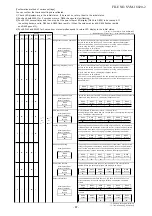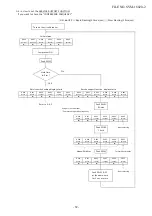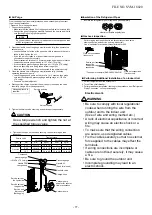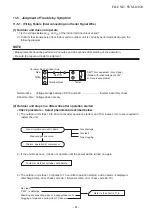
■
Insulation of the Refrigerant Pipes
•
Insulate the refrigerant pipes for liquid and gas separately.
Heat-proof bubble polyethylene
■
Gas Leak Inspection
•
Perform a gas leak inspection for the
fl
are nut connections, valve
stem connection, and service port cap without fail.
•
Use a leak detector exclusively manufactured for R
32
.
Flare nut connections
(Indoor unit)
Flare nut connections
(Outdoor unit)
Service port cap
connection
Valve stem cap
connection
* Check point example (RAS-3M18
U2AVG
-E)
■
Performing Additional Installation of an Indoor Unit
1. Collect refrigerant from the outdoor unit.
2. Turn off the circuit breaker.
3. Perform additional installation referring to the procedure from “Refrigerant
Piping Connection” on the previous page.
Electrical work
WARNING
• Be sure to comply with local regulations/
codes when running the wire from the
outdoor unit to the indoor unit.
(Size of wire and wiring method etc.)
• A lack of electrical capacitance or incorrect
wiring may cause an electric shock or a
fi
re.
• To make sure that the wiring connection
are secure, use designated cables.
• Fix the cables securely so that no external
force applied to the cables may effect the
terminals.
• If wiring connections are incomplete or
cables are not
fi
xed securely, it may cause
a
fi
re.
• Be sure to ground the outdoor unit.
• Incomplete grounding may lead to an
electric shock.
FILE NO. SVM-18020
- 77 -
■
Air Purge
From the sake of environmental protection, use a vacuum pump to extract
the air during installation.
* Prepare a 4 mm hexagon wrench.
1. Connect a charge hose.
• Make sure that the Handle Hi of the gauge manifold valve is closed fully.
• Connect the port of the gauge manifold valve and the service port (Valve
core (Setting Pin)) using the charge hose.
NOTE
If a control valve or charge valve is attached to the charge hose, leak
of R
32
refrigerant can be avoided.
2. Open the Handle Low of the gauge manifold valve fully, then operate the
vacuum pump.
• Loosen the
fl
are nut of the at the gas end a little to make sure that air is
taken in, then tighten the nut.
• If you
fi
nd air is not taken in, make sure that the charge hose is
connected to the port(s) securely.
• Perform extraction for about 15 or more minutes and make sure that the
compound pressure gauge reading is –101 kPa (–76 cmHg).
• If the compound pressure gauge reading is not –101 kPa (–76 cmHg),
there is a possibility air is being taken in from the port(s).
• Make sure that the charge hose is connected to the port(s) securely.
3. Close the Handle Low of the gauge manifold valve fully, then stop
operating the vacuum pump.
• Leave the gauge and pump as they are for 1 or 2 minutes, then make
sure that the compound pressure gauge reading stays at –101 kPa
(–76 cmHg).
• You need not add refrigerant.
4. Disconnect the charge hose from the service port, then open the valve
stem fully using a 4 mm hexagon wrench.
Hexagon wrench is
required.
Service port cap
4 mm
Valve stem cap
5. Tighten the service valve stem cap and service port cap securely.
CAUTION
Use a torque wrench and tighten the nut at
the speci
fi
ed torque value.
6. Tighten all the caps on the valves securely, then perform a gas leak
inspection.
Service valve
Tighten torque
Valve stem cap
Service port cap
Type
mm
N•m
kgf•m
N•m
kgf•m
Liquid side
6.35
14 to 18
1.4 to 1.8
—
—
Gas side
9.52
14 to 18
1.4 to 1.8
14 to 18
1.4 to 1.8
12.7
33 to 42
3.3 to 4.2
14 to 18
1.4 to 1.8
Service valve at
the liquid side
Service valve at
the gas side
Service port
(Valve core
(Setting pin))
Vacuum pump
Handle Hi
(Keep full closed)
Pressure gauge
Manifold valve
Charge hose
Vacuum pump
adapter for counter-
flow preventation
Charge hose
Compound
pressure gauge
–101 kPa (–76 cmHg)
Handle Low
















































